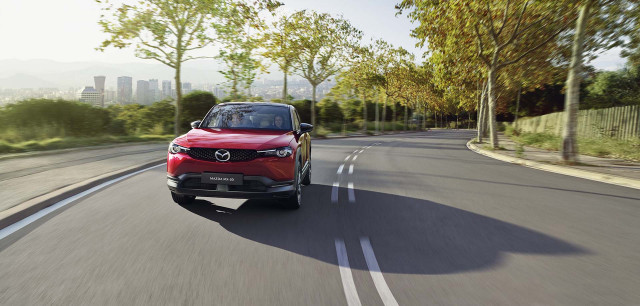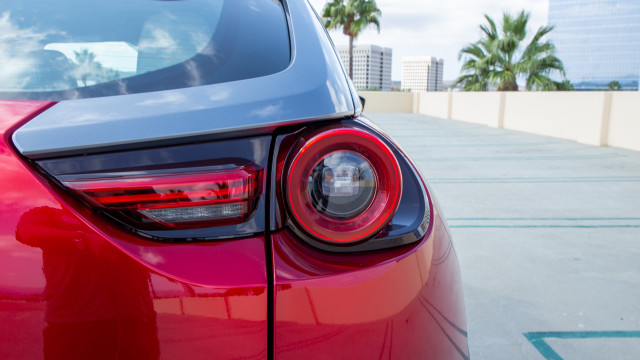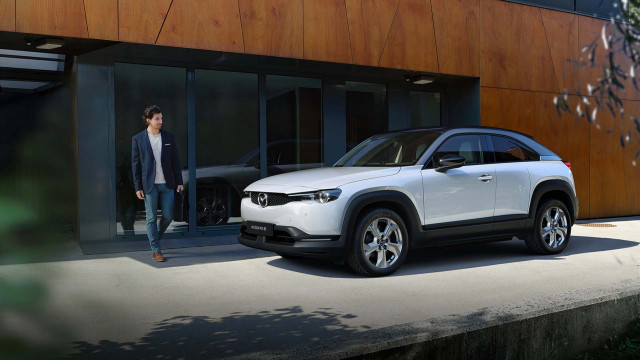LIKES
- A BEV first
- Slab-sided style
- Ride quality
- Steering feel
DISLIKES
- Uncompetitive battery range
- No rotary range extender?
- Lack of rear legroom
- Cumbersome door setup
BUYING TIP
The 2022 Mazda MX-30 puts the Japanese automaker in the battery-electric race, but it’s already running behind.
What kind of vehicle is the 2022 Mazda MX-30? What does it compare to?
The MX-30 is Mazda’s first battery-powered car to be sold in the U.S., but sales are limited to California and its limited range has limited appeal. The small five-seat hatchback compares to electric vehicles like the Kia Niro EV, Mini Cooper SE, and Hyundai Kona Electric.
Is the 2022 Mazda MX-30 a good car?
It’s hard to recommend the 2022 MX-30 given its range limitation of 100 miles, but it earns a decent TCC Rating of 6.8 on the strength of its value, features, and comfortable ride.
What's new for the 2022 Mazda MX-30?
Everything, from the battery pack to the flip-out rear doors. The MX-30 doesn’t get the “CX” designation of Mazda’s other crossovers, but it’s styled more in their vein. The hatchback has flatter body sides and less sculpting in general than the similarly sized CX-30. Rear barn doors open up to an interior lined with cork in the eco-conscious style of the BMW i3.
The battery can be charged to 80 percent in about 36 minutes with DC fast charging, Mazda says. Charging will depend on publicly available Level 2 and DC fast-charge stations; the automaker will connect with ChargePoint to serve its MX-30 drivers.
Inside, the MX-30’s strange shape and doors make for a small backseat that won’t fit adults due to a lack of leg room. However, there’s ample cargo room with 20.4 cubic feet behind the backseats. Go figure.
The electric hatchback comes with automatic emergency braking and other advanced safety features standard, including adaptive cruise control and active lane control. A connected app will allow drivers to monitor the battery’s charge state via mobile devices.
Standard features include an 8.8-inch center display, synthetic leather upholstery, heated front seats, and head-up display.
How much does the 2022 Mazda MX-30 cost?
The MX-30 starts at $34,545 and should qualify for full federal and state tax rebates. Adding on the Premium Plus package bumps the cost up to $37,555.
Where is the 2022 Mazda MX-30 made?
In Japan.
Styling
The MX-30’s boxy styling makes it stand out, but not for good reasons.
Is the Mazda MX-30 a good-looking car?
The MX-30 is based on Mazda’s CX-30 crossover but goes in a different direction with its exterior styling. It’s not a change for the better. A plain interior that belies the funkyness found outside, earning it a plain 5.
Front the beltline down, the MX-30 is rather conventional with prominent plastic cladding and Mazda’s angular nose. But on top it deviates completely with a high-sided greenhouse and sharply sloping rear-roof line. The rear doors have also been flipped and open backwards (Mazda dubs them “free-style”), a la the old RX8. Premium Plus models also feature three-tone paint jobs that make the roof stand out.
Performance
A smooth, composed ride is the MX-30’s best attribute.
Though the MX-30 lacks the instant acceleration found in many of its counterparts, its well-tuned steering and good ride quality earn it an extra point to give the SUV a 6 here.
Is the Mazda MX-30 4WD?
It is not. The MX-30 only comes with a single 80.9-kw electric motor that drives the front wheels and produces 143 hp and 200 lb-ft of torque. Power comes from a 35.5-kwh battery pack, mounted beneath the passenger compartment floor.
By EV standards, not very fast at all. Mazda says that the accelerator pedal has been tuned to provide acceleration more like a gas engine, so it lacks the snappy off-the-line feel that many of its EV competitors provide. The MX-30 offers five different regenerative braking settings but none of them provide one-pedal driving and in the two highest regeneration levels the throttle takes too much pedal effort to get the MX-30 moving. Similarly, the brake pedal doesn’t feel well tuned and it’s hard to stop smoothly.
Luckily for the MX-30, its handling and comfort are impressive. It flips the CX-30’s 60/40 front/rear weight distribution to 40/60 and the nose feels light and agile. The 683-pound battery pack stuck in the frame lowers the crossover’s center of gravity, making it more stable at all speeds.
There is an artificial engine noise that can’t be turned off; fortunately it’s inoffensive and fades into the background quickly.
Comfort & Quality
Those strange rear doors make for a tiny entryway into a tiny backseat.
The MX-30 earns a point each for its materials quality and cargo capacity, but gives one right back with a tiny backseat that won’t fit adult passengers. That makes it a 6.
Similar to the CX-30, the front seats are comfortable and the materials generally look and feel a touch above what you’ll find in most mainstream vehicles. Cork trim pieces help to break up a mostly black interior and hint at the EV’s green nature. Behind the rear seats is 20.4 cubic feet of cargo space, which puts it in similar standing with other small crossovers. The rear seats fold down for more space, but Mazda did not provide a larger cargo volume measurement.
Where the MX-30 falls short is its rear seats. The rear-hinged doors make entering awkward and if you do make it back there it will be an extremely tight squeeze. Adults can’t sit back to back, and there isn’t enough leg room or a good place to put your feet. The official measurement is 30.1 inches of rear legroom but it feels more like 30.1 centimeters.
Safety
The MX-30 has yet to be crash tested by either safety agency.
How safe is the Mazda MX-30?
It has yet to be crash tested by either the NHTSA or the IIHS so we can’t give it a final rating, but the MX-30 comes with an impressive amount of standard safety equipment. Forward automatic emergency braking, active lane control, adaptive cruise control, and blind-spot monitors come standard. Front parking sensors and blind spot assist are also available.
Features
Both MX-30 models are well equipped and offer lots of value after tax credits.
The MX-30 gets a leg up on value thanks to its tax credit eligibility and it earns additional points for excellent base content and a large infotainment screen to give it a 7.
Which Mazda MX-30 should I buy?
The base model is very well equipped and will be the right model for most buyers. It comes standard with an 8.8-inch center display, synthetic leather upholstery, heated front seats, a head-up display, and Android Auto/Apple CarPlay connectivity. The screen is not a touchscreen, a knob is used to navigate around the various menus and it takes some time to get accustomed to.
Loading up the MX-30 with the Premium Plus package adds $3,010 to bring the total price to $37,655 and for that you get a few more safety features, Bose audio, a heated steering wheel, and a surround view camera. If any of those are must-have features, take the leap but the base model will be just fine for most.
The battery comes with an 8-year/100,000-mile warranty, but the rest of the vehicle is covered by a 3-year/36,000-miles basic warranty.
Fuel Economy
Range anxiety will be a constant companion in the MX-30.
The most disappointing part of the MX-30’s arrival (apart from there only being 560 units available its first year of production) is its range. Its paltry 100 miles of EPA-estimated range is enough to earn the MX-30 a 9 on our scale, but that puts it far, far behind EVs such as the Volkswagen ID.4 and Kia Niro EV that both offer more than 200 miles of range.
Mazda includes 10 days of loaner cars from a Mazda dealership for the first three years of ownership, in case you need to go on longer trips. But that doesn’t fix the MX-30’s day-to-day limitations.










Information is pretty good and impressed me a lot for Sales video production company . This article is quite in-depth and gives a good overview of the topic.
ReplyDelete